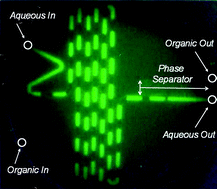Liquid–liquid phase separation: characterisation of a novel device capable of separating particle carrying multiphase flows†
Abstract
Capillary forces on the microscale are exploited to create a continuous flow liquid–liquid phase separator. Segmented flow regimes of immiscible fluids are generated and subsequently separated into their component phases through an array of high aspect ratio, laser machined, separation ducts (36 µm wide, 130 µm deep) in a planar, integrated, polytetrafluoroethylene (PTFE) microdevice. A controlled pressure differential across the phase separator architecture facilitates the selective passage of the wetting, organic, phase through the separator ducts, enabling separation of microfluidic multiphase flow streams. The reported device is demonstrated to separate


 Please wait while we load your content...
Please wait while we load your content...